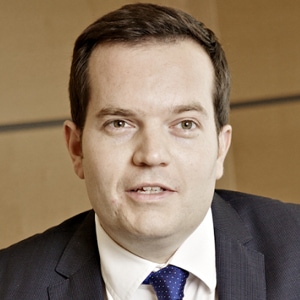Predicting the future is a fool’s game, but a fun one. Global Finance considers where today’s innovations may eventually lead.

What will the world of financial services look like in 10 or 20 years? If anyone knows, it’s probably Peter Randall, a founder and former CEO of multilateral trading facility Chi-X Europe (now called Bats Europe), which took on the incumbent stock exchanges in Europe and won significant market share in pan-European equity trading.
Now, as CEO of SETL, an institutional payment and settlement infrastructure based on blockchain technology, Randall believes he is on the cusp of another

major wave of transformation driven by technological innovation in financial services—a wave that will fundamentally change how securities and payments are cleared and settled and the incumbent organizations whose monopoly on these processes has not been challenged until now.
“In the 1970s, it was SWIFT [the global financial-messaging network that started out using the telex] that was considered revolutionary. Then in the 1980s, it was dematerialization of stocks and bonds,” says Randall. “In the 1990s, it was the establishment of central counterparty clearinghouses; and in the first decade of the 21st century, it was the application of technology to trading systems like Chi-X.” Now, he says, blockchain is the next wave of innovation to transform the post-trade industry.
Throughout history, there have been major transformative periods where a single innovation—the printing press, the internal combustion engine or binary code—has wrought profound social and economic changes over the next century that few could have foreseen at the time. At the same time, some of the dreams concocted have not materialized. Our cars do not yet fly.
Today, the financial world is at the cusp of enormous change that renders the future both exciting and murky. Blockchain, artificial intelligence (AI), machine learning and robotic process automation (RPA) hold all sorts of promises for solving the banking problems of today. When these technologies are fully realized, what will banking look like?
“Can you envision branches and operation centers staffed by sophisticated robots instead of human tellers? Or picture everyone from high net worth investors to high school teachers taking financial advice from artificially intelligent apps and then investing across asset classes, currencies and geographies on a real-time basis? Or imagine if launching a bank, an asset manager or an insurance company were as simple as plugging in an appliance?” asks PwC in its Financial Services Technology 2020 and Beyond: Embracing Disruption report.
“This is not fantasy; it is where things are headed,” says the report. The consultancy adds that the bank of the future is likely to be low cost, digital or mobile only, offer cross-border payments for nothing and hedge currency risk using cryptocurrencies.
Gil Mermelstein, managing director at business and technology consultants West Monroe Partners in New York, believes that the biggest changes will occur in consumer banking, which he says in 20 to 30 years will largely be conducted via nontraditional providers. “I don’t know whether you’ll be able to call it a bank anymore,” he says. “It will be more like a utility.”
Banks of the future will have no back offices, Mermelstein ventures: “They will look more like technology companies.” He also believes that the future financial system will be more egalitarian, with small and midsize companies having better access to capital due to the proliferation of peer-to-peer networks that use AI to make lending decisions.
In this futuristic scenario, Mermelstein believes the human factor won’t disappear altogether—it will still be important in the world of corporate and investment banking, which is relatively riskier. However, payments and FX could move away from banks altogether, he says, and capital market intermediaries like broker-dealers may be eliminated or shrink. And if financial markets run on the blockchain, then everyone will have close to perfect information in a highly efficient market.
BUILDING BLOCK OF THE FUTURE
“Today, almost every ledger entry in almost every aspect of financial services entails the movement of cash or collateral, whether it’s operating CLS Bank or a CSD [central securities depository] moving stock against cash,” says Randall. “I see these ledgers rolling into one another. It will be cheaper to run them in a distributed way.” Randall believes blockchain means banks will no longer need to worry about reconciliation, a major headache today, as the ledger is shared and updated in real time.

In this so-called utopia of a blockchain-based capital market system, there “would be no need to operate data normalization, or … agree [on] exposures and obligations,” states international management consultancy Oliver Wyman in a February 2016 report on Blockchain in Capital Markets: The Prize and the Journey. “We would have standardized processes and services, shared reference data … near real-time data and improved understanding of counterparty worthiness. For privileged participants such as regulators, we would have transparent data on holdings, among many other improvements.”
To better understand where financial markets are headed as they ride this current wave of innovation, let’s see where they are so far on their journey. Randall says SETL has solved the issues of privacy, cybersecurity and scalability (SETL can reportedly handle 300,000 transactions per second), which have held blockchain back. And it has “real implementations receiving real money,” including a contactless smartcard-enabled blockchain for digitized payments and an FX post-trade platform that will use SETL’s OpenCSD platform to create a single, shared view of each FX transaction. SETL is also working on an alternative clearing and settlement infrastructure for the Australian market, to replace one currently operated by the Australian Securities Exchange.
But if blockchain is to proliferate in financial markets in 10, 20 or even 30 years, then it needs to overcome what PwC refers to as implementation challenges. “While most of the technological risks are currently being addressed by developers, academics and businesses,” it writes in its Global FinTech Report 2017, “there is still a lot of regulatory and legal uncertainty for some of the emerging business use cases.”
“Blockchain may be interesting for identity management and Know Your Customer, but it’s possibly less interesting in high-volume use cases because of latency,” says Ben Robinson, chief strategy officer at core banking systems software provider Temenos. “In the corporate world, smart contracts, together with the Internet of Things, speeding up supply chain transactions and being able to track goods embedded with chips in transit, are all interesting use cases for blockchain. But for large-volume payments, most jurisdictions are moving to Faster Payments [a UK banking initiative to shorten settlement times], so the business case for blockchain there is less compelling.”
Kevin Johnson, head of innovation programs at Innotribe, a SWIFT initiative to foster bank-fintech collaboration, says fintech and regulatory technology (regtech) companies (which encompass AI, machine learning, robotic processing and blockchain) will need to move out of the lab, scale up and prove themselves. “It’s no longer innovation for innovation’s sake,” he says. “Solving customer problems is at the core of everything.”
Banks are starting to invest in technologies that have a more immediate payback and impact on their business. PwC’s Global FinTech Report 2017 says that 30% of large financial institutions identified AI as the most relevant emerging technology for investment in the coming years, compared to just 19% for blockchain.
“We see a role for AI, not in replacing people but augmenting them; helping humans perform more value-added roles; freeing them up to do other stuff and to build relationships with customers,” says Peter McElwaine-Johnn, principal director of technology strategy at Accenture.
In the future, banks are likely to move from a mobile-first to an AI-first strategy. In its Technology Vision 2017 report, Accenture proclaims that “AI is the new UI” (user interface). More than 70% of banks surveyed in the report expect AI interfaces (chatbots) to be the primary point for customer interaction in the next three years. It could take much longer than that before AI becomes the predominant means of communication between corporations and their banks; although AI is already being used, to some extent, to service high net worth clients in private banking.
Nevertheless, AI is moving at a much faster pace than blockchain, says Mermelstein: “The applications of [AI] are enormous in solving real problems banks are facing.” AI could be used to detect fraudulent transactions or to market cross-channel to ensure banks are getting the “biggest bang for their buck” or to analyze nontraditional data to lend to businesses that banks do not normally lend to; the list goes on.
Could AI be the next big thing in anti–money-laundering (AML) detection? One of the biggest problems banks currently face is that AML software systems produce a high number of false positives. “Would employing robots get rid of false positives?” Anthony Fenwick, managing director and global head of treasury and trade solutions AML compliance at Citi, asked at SWIFT’s April London Business Forum. “We need to do a lot more testing,” he says, adding that the human element in AML is unlikely to disappear altogether, no matter how smart the robots get.
Scientists may dream of a future where AI is more intelligent than humans, or where machines can create an abstraction or new idea from data; but these advances are at least another decade or two away. “AI is becoming smarter, more humanlike,” says McElwaine of Accenture. “But how do you get something that is smart like us, but that doesn’t make mistakes?”
One thing that is likely to hold back AI’s progress in the coming years is banks’ existing data architectures. “Banks are not doing AI on a broad basis because of dirty data,” says London-based fintech commentator Chris Skinner. “A lot of Tier 1 banks are struggling with their data.” Skinner says banks will need to transition these structures into the private Cloud to support data going into AI.
In the past, overcoming the limitations of data architectures was time-consuming and costly. Now, the larger banks are creating “data lakes,” because they can draw insights from them. “The idea of a data lake is to pull together all the data [e.g., customer interactions, emails, photos, account balances and transactions] and run queries across it,” explains Accenture’s McElwaine. “Five years ago, the technology to do this didn’t exist.”
McElwaine says data lakes will also help banks better deal with the uncontrollable number of requests for customer-account data they are likely to receive from third-party application programming interface (API) developers under a new regime referred to as open banking. Open banking is mandated under Payment Services Directive 2 in Europe, which will be enforced as of January 2018.

Under open banking, “banks will become curators of API services,” says Skinner. It could also help regulators. According to McElwaine, the Austrian central bank is exploring whether it can get all banks to expose APIs in real time. “Now, a lot of regulation is after the fact,” he explains, “but if you can access what is going on in real time, you can do your job better.”
A new era of open-banking APIs could also see future innovations in financial services shift from today’s largely western bias to regions of the world such as Asia and Africa. Johnson cites the example of Africa, where Innotribe expanded its Startup Challenge two years ago. “We’re not seeing a huge amount of AI in these markets,” says Johnson, “but there are start-ups like WeCashUp in Africa, which provides an API for connecting mobile wallets.” China’s WeChat Pay, which is owned by Tencent, is expanding into Europe; and Alipay, a payment arm of Chinese ecommerce giant Alibaba, recently launched its payments platform in the US.

Open banking may also open doors for Internet giants Google, Amazon and Facebook to move into financial services. “We haven’t seen the Amazon of banking yet,” says Robinson of Temenos. “These companies already help us navigate our data, which could help us make better financial decisions. [Open banking] has driven the wedge right open.” Open banking is also likely to result in much faster, higher-volume payments and smaller-value micropayments, says Robinson.
Of course, in this utopian world of AI, open banking and capital markets running smoothly on blockchain, the need for cybersecurity isn’t abating. In fact, developing more touch points for customers is likely to create more avenues of attack for fraudsters and hackers.
“We need cybersecurity, not as an afterthought, but built into the design of applications,” says Johnson. Can things go wrong with smarter, more sophisticated banking applications? “Absolutely,” says Mermelstein. “We should be more concerned about hackers taking control of things. But again, AI can also help with that.”
One thing AI may not be able to help with, however, is the loss of jobs. If the bank of the future has no back office, as Mermelstein predicts, and few, if any, human employees—as machines and AI-driven chatbots do most of the grunt work and interact with customers—then what will the bankers of tomorrow do?
Data scientists, not bankers, will be in high demand; and countries like India and the Philippines, which are the back offices of the world, will have to reinvent themselves.



